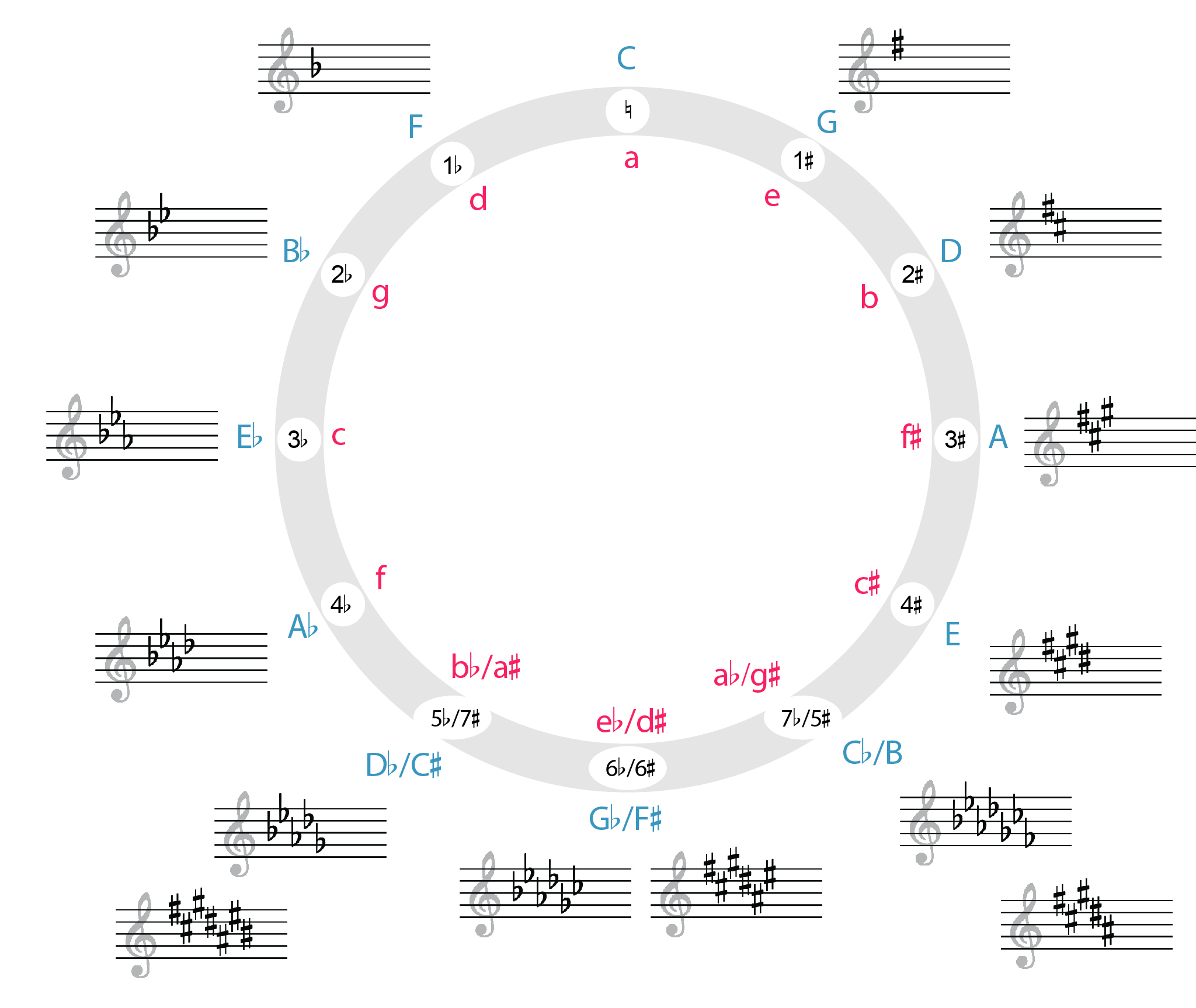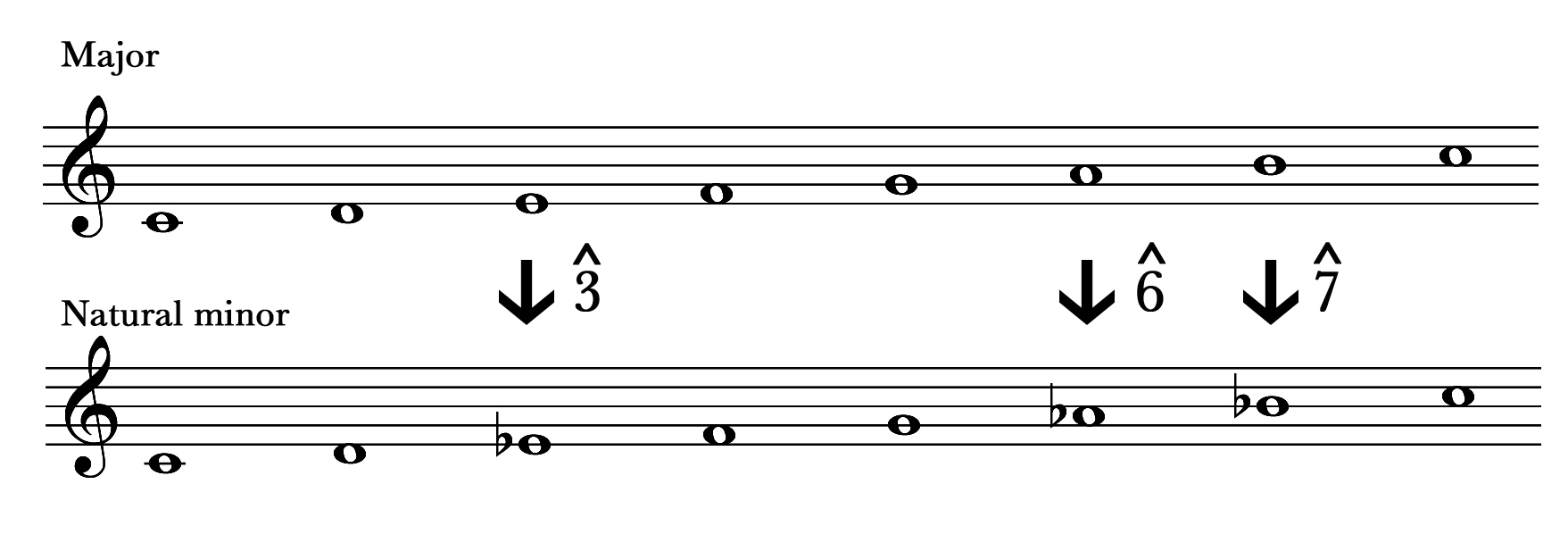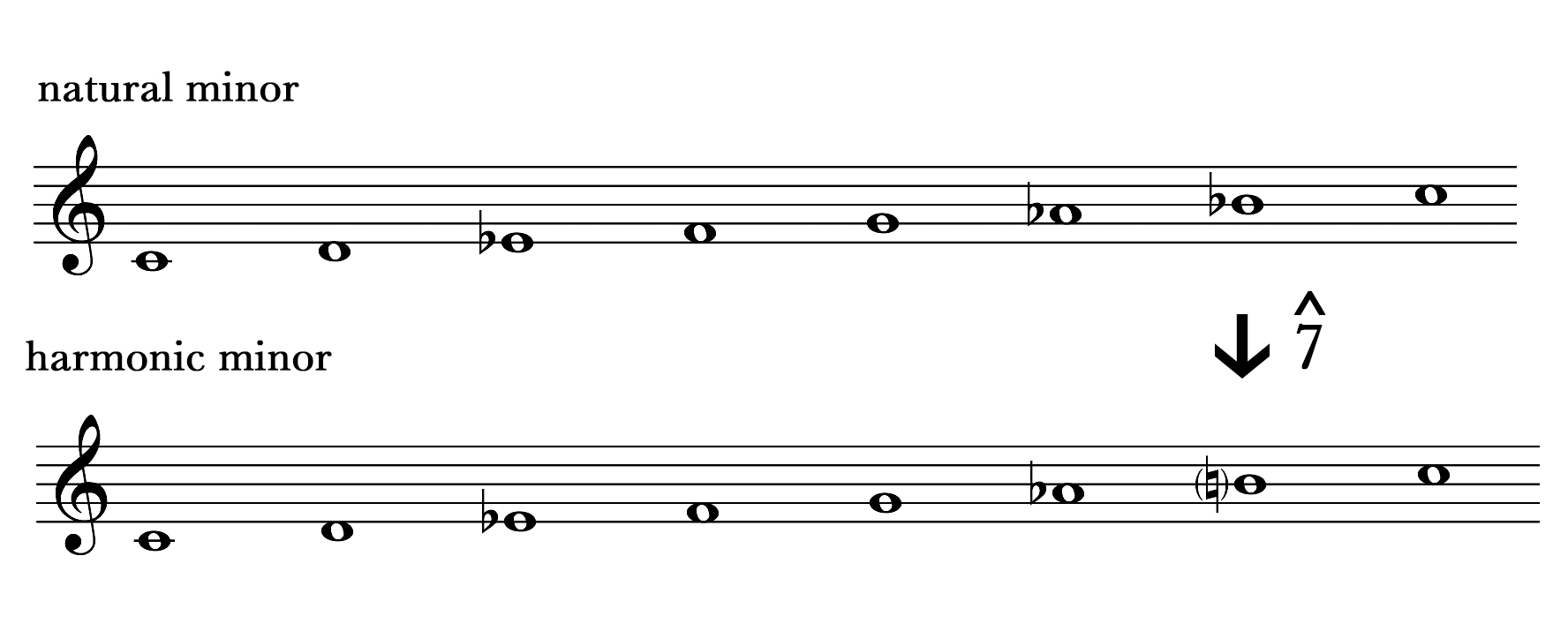3.3 Minor Scales: Tutorial
Relationships between Major and Minor keys
Just like we have 15 major keys in music, we also have 15 minor keys in music. Minor keys are related to major keys in one of two ways. They can have either a parallel relationship or a relative relationship.
Keys that are parallel share the same tonic, but have different key signatures. C major and C minor are parallel keys. C major has no sharps or flats while C minor has 3 flats.
To find the key signatures for parallel keys when going from major to minor, take away 3 accidentals from the key signature if using sharps, or add 3 accidentals to the key signature if using flats. If starting in C major, with no sharps or flats, if you decrease the key signature by 3 accidentals you are adding 3 flats to find the key signature to get C minor. If you were in A major, with 3 sharps, you’d take away all 3 sharps and find that A minor has zero sharps or flats.
To find the key signature for parallel keys when going from minor to major, add 3 accidentals if using sharps, and take away 3 accidentals if using flats. For example, to find the parallel major key of E minor, which has 1 sharp, you’d add 3 more sharp for a total of 4 sharps in the key of E major. To find the parallel key of Ab minor, which has 7 flats, you’d take 3 away for a total of 4 flats in the key of Ab major.
Keep in mind that not all major keys have parallel minor keys. For example, while we have Db major, we do not have Db minor as a key. Here’s a list of keys that do not have a parallel relationship.
- Db major but no Db minor
- no D# major but D# minor
- Gb major but no Gb minor
- no G# major but G# minor
- no A# major but A# minor
- Cb major but no Cb minor
Keys that are relative share the same key signature but have different tonics. C major and A minor are relative keys. Both share the same key signature, but start on different notes. All major keys have a relative minor key.
To find a relative minor key when starting with a major key, count down 3 half steps from tonic to find the name of the key. For example, if in D major, 3 half steps below D would be B, which means D major and B minor are relative keys that share a key signature.
To find a relative major key when starting with a minor key, count up 3 half steps from tonic to find the name of the key. For example, if in G minor, 3 half steps up would be Bb, which means G minor and Bb major are relative keys with the same key signature.
The Circle of 5ths
The minor keys in music can be added to the circle of 5ths along with the major keys to give a visual picture of all major and minor key signatures and their relationships. Because the Circle of 5ths is organized by key signatures, major and relative minor keys are grouped together around the circle. Remember, to find a relative minor key from a major key, you count down 3 half steps from tonic. The circle starts with C major and A minor in the top center because they have no sharps or flats. It then moves clockwise around the circle in 5ths, adding a sharp with each new key. It also moves counterclockwise by 4ths, adding a new flat with each new key. There are 3 enharmonic keys for minor, just like there are for major.

Minor Scales
In a major key, a major scale is built from its key signature. In minor keys, there are three versions of the minor scale that can be used: the natural minor scale, the harmonic minor scale, and the melodic minor scale. While 3 forms of the minor scale exist in each key, it’s important to remember that they are all used in the same minor key and will share the same key signature.
Natural minor
The natural minor scale is built from the notes in the key signature without any alterations and uses the same notes when ascending and descending. It uses a step pattern of W H W W H W W. You can also think of a natural minor scale like a major scale with lowered scale degrees 3, 6, and 7. However, it’s much faster to memorize minor key signatures when building scales instead of counting steps between notes. In the example below, the key of C minor has 3 flats, so a natural minor scale starting on C will have Bb, Eb, and Ab.

Harmonic minor
The Harmonic minor scale is like natural minor with a raised 7th scale degree both ascending and descending. We raise scale degree 7 in order to create a leading tone. A leading tone is needed in both a major and minor key in order to lead to tonic. In order to create the needed harmony, the harmonic minor scale is used. We’ll discuss raising the leading tone to create necessary harmonies in more detail when building chords in music.

Melodic minor
The melodic minor scale evolved from the need to raise the leading tone but to make the scale easy to sing. If you listen to the harmonic minor scale, you’ll hear a big interval (3 half steps) between scale degrees 6 and 7. That awkward, dissonant interval is hard to sing when used in a melody, so the melodic minor scale was created to smooth out that leap and make it pleasing to the ear and easy to sing.
The melodic minor scale is like a natural minor scale with raised scale degree 6 and 7 when ascending. It reverts back to natural minor without any accidentals outside of the key signature when descending. It is the only scale that changes the notes when descending. Why does it change? Typically in music, notes that are raised ascend to resolve, while notes that are lowered descend to resolve. The natural minor scale doesn’t contain any awkward intervals to sing, so the scale can revert to natural minor when descending.

Scale Degree Names in Minor
The scale degree names in a minor scale are the same as those in major with one addition. If the leading tone is not raised, it is not functioning as a leading tone, and therefore we call it the subtonic because it is below tonic.
| Scale Degree | Name | Name comes from |
| 1 | tonic | “home base,” most stable pitch, beginning and end point |
| 2 | supertonic | Pitch right above tonic (super means above) |
| 3 | mediant | Pitch halfway between tonic and dominant |
| 4 | subdominant | Pitch right below the dominant (sub means below) |
| 5 | dominant | Dominant to tonic motion is important in tonal music. We can see one instance of that in the Circle of 5th motion through keys in music. |
| 6 | submediant | Sub in this case means opposite the mediant. The mediant is a 3rd above tonic and the submediant is a 3rd below the tonic. |
| 7 | leading tone | The leading tone is a tendency tone with a strong drive to lead to and resolve to scale degree 1. |
| b7 | subtonic | When scale degree 7 has not been raised in a minor key, it is called the subtonic because it is below tonic. |
Determining the Key of a Piece
When looking at a piece of music, the first step toward determining the key is to look at the key signature. A key signature will have a major key choice and a minor key choice. In order to determine if the piece is in major or minor, look at the first and last notes. Typically, those will be tonic, or will be part of the tonic triad (scale degrees 1, 3, or 5). A piece in a minor key most often will have a raised leading tone (scale degree 7). Look at the example below. It has 3 flats, which could be either Eb major or C minor. It starts and ends on C, which supports C minor. It also uses B natural. If that note was raised in a major key, it would be scale degree 5, which would make no sense since the dominant is very important in any key and would not be raised. However, in C minor, raising B does make sense since it is scale degree 7 in that key, which would create a leading tone. While you could listen to this example to hear if it’s in major or minor, it’s also important to be able to look at a piece of music without hearing it and be able to use your theory knowledge to determine the key.

The questions raised when looking at major keys and scales also apply to minor keys: Can you identify other scales or scale fragments in your music? How are they used? Do they help to outline the key? Do they help transition away? What key is your music in? Does it stay in one key for the whole piece? Why do you think the composer chose that key (Practicality, Character/Emotional association)? How often are tonic and dominant used in the music? Can you hear how the leading tone in a key has a strong tendency to resolve to tonic when it’s in the melody and the harmony?
In addition, think about why a composer might choose a minor key instead of a major key when writing a piece. If you are currently playing or studying a piece in a minor key, which form or forms of the minor scale are used? Do you hear a raised leading tone? How are scale degree 6 and 7 used in the melody versus in the harmony? Try altering which form of the minor scales are used to see how and why composers chose one over the other. If you are playing a piece in a major key, try transposing it to minor to see how that changes the feel of the piece.

